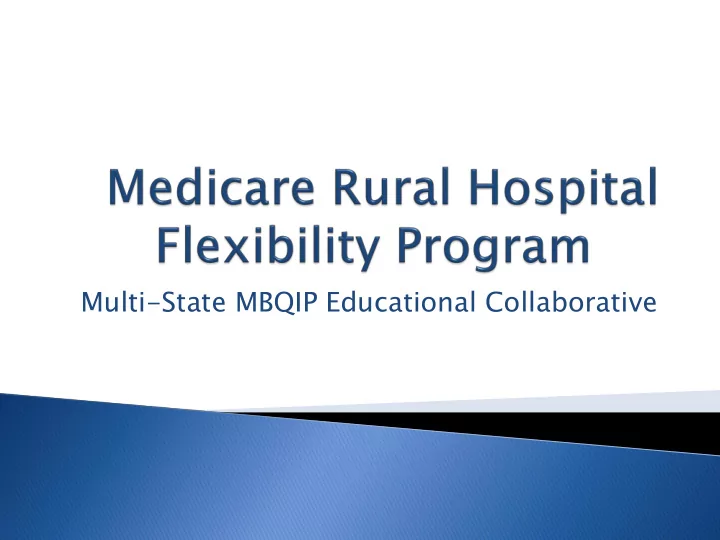

Multi-State MBQIP Educational Collaborative
Illinois Department of Public Health – grantee and subcontracts with the Illinois Critical Access Hospital Network (ICAHN) ◦ Partners: Illinois Health and Hospital Association; universities; stroke and CHNA (community health needs assessment) consultants; rural accountable care organization (ACO) ◦ ICAHN manages activities/program ◦ Focus areas…peer groups/list servs/projects 51 critical access hospitals (CAHs) ◦ 33 Independent; 18 system facilities ◦ No closures – remaining financial viable ◦ 40/51 participating in some type of ACO
Administered by the Wyoming Department of Health, Public Health Division, Office of Rural Health Supports 16 CAHs Partners with: ◦ Wyoming Hospital Association as a fiscal manager ◦ Rural Health Solutions and Quality Reporting Services for Medicare Beneficiary Quality Improvement Project (MBQIP) activities and technical support ◦ Mt. Pacific Quality Health for statewide collaborative projects
Administered by the California Department of Health Care Services, State Office of Rural Health Partners with: ◦ California Hospital Association/Health Foundation Trust for financial/operational improvement activities ◦ Rural Health Solutions for MBQIP activities ◦ California Critical Access Hospital Network (CCAHN) for statewide projects Supports 34 critical access hospitals
The Quality Health Indicator (QHi) web site was developed through the Kansas Hospital Association and the Kansas Rural Health Options Project to as a benchmarking tool for rural Kansas hospitals. Provides hospitals with a tool to evaluate internal processes of care and to seek ways to improve practices by comparing specific measures of quality with like hospitals. Hospitals can select from a library of indicators to determine which measures meet their unique needs.
Flex Administration ◦ Use of QHi State Administrators ◦ Overlapping activities ◦ Recognition of limited resources ◦ Willingness to collaborate and contribute resources to collaboration ◦ Started our conversations mid-April
Staff turnover in critical access hospitals Inconsistent reporting Use of data analysis to identify focus areas State and National Averages
State responsibilities based on expertise and strengths Planning meetings on focus areas, resources, efficiencies and responsibilities Wyoming was already developing Emergency Department Transfer Communication (EDTC) webinars California identified Hospital Consumer Assessment of Healthcare Providers and Systems (HCAHPS) as a focus area Illinois identified Immunization challenges as focus area Collaboratively looking at capacity building of the outpatient (OP) measures Costs absorbed by each state Planning and Scheduling ◦ Each state is responsible for developing and scheduling activity for area of focus ◦ Other states are responsible for disseminating information to their hospitals
EDTC HCAHPS PS Immun uniz izatio ion Webinar Series Webinar Series Marketing Materials EDTC Focused Quietness in Best Practice tools Measures: Hospital such as newsletter EDTC #6 articles, fun games to EDTC #4 engage employees EDTC #5 EDTC #1 Presentations Response Rate materials are available at: www.wyqim.com Transitions of Care Measures
Enhancement of core competencies for our state Flex Programs ◦ Building partnerships ◦ Improving processes ◦ Promoting quality reporting and improvement ◦ Management of Flex program resources as efficiently as possible ◦ Sharing and using lessons learned and best practices Adapting to Change ◦ As reporting becomes a requirement for participation, Flex Programs will have more work with the same resources
Critical Access Hospitals offered more resources More consistent reporting Improved scores Networking
New ideas to improve engagement Greater participation improves reliability of benchmarking and quality scores Share training and marketing costs Why recreate the wheel?
Jennifer Brooks, California Flex Coordinator Michelle Hoffman, Wyoming Flex Coordinator Pat Schou, ICAHN Executive Director/Illinois Flex Program
Recommend
More recommend